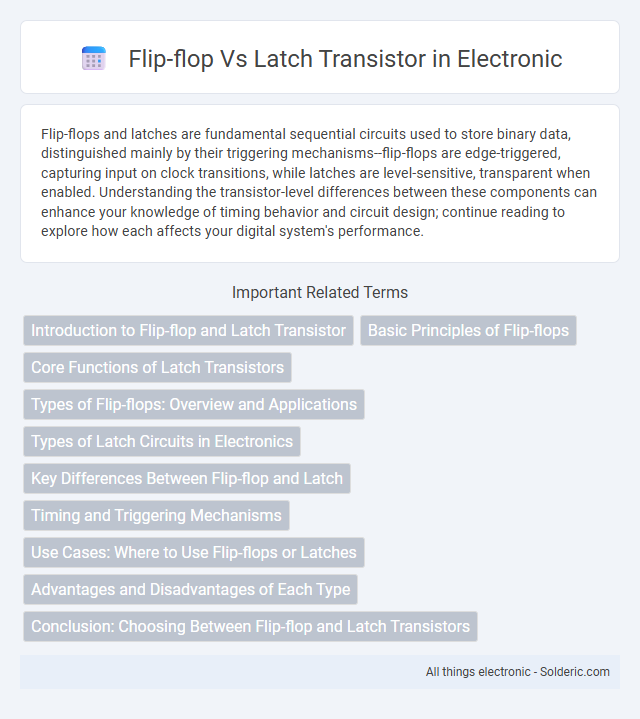Flip-flops and latches are fundamental sequential circuits used to store binary data, distinguished mainly by their triggering mechanisms--flip-flops are edge-triggered, capturing input on clock transitions, while latches are level-sensitive, transparent when enabled. Understanding the transistor-level differences between these components can enhance your knowledge of timing behavior and circuit design; continue reading to explore how each affects your digital system's performance.
Comparison Table
| Feature | Flip-Flop | Latch |
|---|---|---|
| Definition | Edge-triggered storage device | Level-triggered storage device |
| Trigger Type | Triggered on clock edge (rising or falling) | Triggered when input level is high or low |
| Data Storage | Stores data on clock edge | Stores data as long as enable signal is active |
| Timing Control | Controlled by clock signal edge | Controlled by enable signal level |
| Use Cases | Used in synchronous circuits for precise timing | Used in asynchronous circuits or simple memory elements |
| Complexity | More complex design | Simple design |
| Power Consumption | Higher due to clocked operation | Lower power in static conditions |
| Example | D flip-flop, JK flip-flop | SR latch, D latch |
Introduction to Flip-flop and Latch Transistor
Flip-flops and latches are fundamental building blocks in digital electronics, used for storing and transferring data based on transistor switching. A latch transistor operates as a basic memory element that holds a state as long as the enabling signal is active, while a flip-flop transistor stores data on the edge of a clock pulse for synchronized circuit operation. Understanding the differences between these components is crucial for designing reliable sequential logic circuits and improving your digital design's timing accuracy.
Basic Principles of Flip-flops
Flip-flops are bistable devices that store binary data using a controlled clock signal, ensuring data changes only occur at specific clock edges. Unlike latches, which are transparent when enabled, flip-flops maintain stable output by capturing input only during a clock transition, making them essential for synchronous circuit design. Your digital system's timing accuracy depends on selecting flip-flops for reliable state retention and precise data synchronization.
Core Functions of Latch Transistors
Latch transistors primarily serve as memory elements by holding a stable logic state until triggered to change, enabling data storage in digital circuits. Their core function involves continuous transparency during the enable signal, allowing input signals to pass through and be stored. You rely on this fundamental behavior in applications requiring reliable data retention and synchronization within sequential logic designs.
Types of Flip-flops: Overview and Applications
Flip-flops are bi-stable circuits that store binary data, with common types including SR, D, JK, and T flip-flops, each offering specific functions for edge-triggered data storage and synchronization in digital systems. D flip-flops are widely used in registers and memory devices due to their simplicity and reliability in capturing data on clock edges, while JK flip-flops provide toggling capabilities ideal for counters and frequency dividers. T flip-flops serve efficiently in toggle operations, and SR flip-flops offer basic set-reset functionality, making them fundamental in control logic circuits and state machines.
Types of Latch Circuits in Electronics
Latch circuits in electronics primarily include SR (Set-Reset) latches, D (Data) latches, and JK latches, each serving distinct control functions within digital systems. The SR latch operates with two inputs to maintain a binary state, while the D latch captures and holds data based on a control signal. JK latches, more versatile, overcome the ambiguity issues of SR by toggling states, making them essential for memory and sequential logic applications.
Key Differences Between Flip-flop and Latch
Flip-flops are edge-triggered devices that store data on clock signal transitions, while latches are level-triggered and store data as long as the enable signal is active. Flip-flops maintain data stability through clock edges, making them suitable for synchronous circuits, whereas latches may cause timing issues due to their transparent nature during enable periods. The key difference lies in their timing control: flip-flops update data only at clock edges, whereas latches can change output immediately with input changes when enabled.
Timing and Triggering Mechanisms
Flip-flops and latches differ significantly in timing and triggering mechanisms, where flip-flops are edge-triggered devices responding to clock signal transitions (rising or falling edges), ensuring precise timing control in synchronous circuits. Latches are level-triggered, transparent when the enable signal is active, which can cause timing uncertainties due to their sensitivity to input changes during this period. Your choice impacts circuit stability and timing behavior, making flip-flops preferable in controlled clock environments and latches suitable for simpler or asynchronous applications.
Use Cases: Where to Use Flip-flops or Latches
Flip-flops are ideal for synchronous circuits requiring precise edge-triggered data storage, such as counters, registers, and memory devices, ensuring data changes only on clock edges. Latches suit asynchronous applications like level-sensitive data storage, transparent data transmission, and simple control signals due to their ability to capture input as long as enable signals are active. Your choice depends on whether your design demands strict timing control with clock pulses or flexible, level-based data latching.
Advantages and Disadvantages of Each Type
Flip-flops offer edge-triggered data storage, ensuring precise synchronization in digital circuits, which reduces timing errors but often require more transistors and consume more power compared to latches. Latches provide level-triggered storage with simpler transistor structures, allowing faster data access and lower power consumption though they are prone to glitches due to transparency during active levels. Understanding these trade-offs helps you select the optimal device for your circuit's speed, power, and complexity requirements.
Conclusion: Choosing Between Flip-flop and Latch Transistors
Flip-flop transistors provide reliable edge-triggered data storage ideal for synchronous circuits, whereas latch transistors offer transparent data holding useful in asynchronous designs. The choice depends on timing requirements; flip-flops suit systems needing precise control, while latches favor faster, simpler data retention with less delay. Designers prioritize flip-flops for clocked sequential logic and latches for low-latency or level-sensitive applications.
Flip-flop vs Latch transistor Infographic

 solderic.com
solderic.com